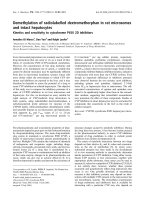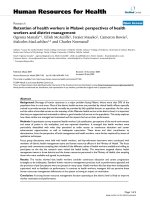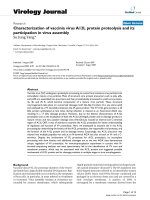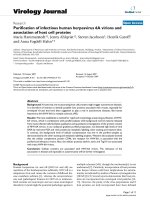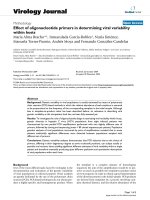Báo cáo sinh học: " Regulators of kinesin involved in polarized trafficking and axon outgrowth" potx
Bạn đang xem bản rút gọn của tài liệu. Xem và tải ngay bản đầy đủ của tài liệu tại đây (96.39 KB, 4 trang )
Minireview
Regulators of kinesin involved in polarized trafficking and axon
outgrowth
Shuo Luo and Michael L Nonet
Address: Department of Anatomy and Neurobiology, Washington University School of Medicine, 660 S. Euclid Avenue, Saint Louis,
MO 63110, USA.
Correspondence: Michael L Nonet. Email:
Vesicle trafficking and neurite outgrowth
Neurons adopt a unique morphology that is different from
other cell types in that they extend dendrites and axons
from their cell bodies. The dendrites and axons serve two
main purposes: to connect distant cells by extending projec-
tions between the pre- and postsynaptic targets, and to
direct electric signal flow within neurons. Both functions
require the proper outgrowth and polarization of neurites,
which develop into dendrites and axons.
One of the common mechanisms underlying the outgrowth
and polarization of developing neurites is the targeted traf-
ficking of vesicles to the growing neurite tips [1]. One
source of materials needed for this growth is thought to be
exocytic vesicles derived from the trans-Golgi network.
These vesicles are transported to sites of growth, where they
fuse with the plasma membrane to deliver polarized mem-
brane proteins to the growing neurite. In support of this
idea, live imaging of amyloid precursor protein (APP) and
synaptophysin, two axonal targeted proteins, tagged with
fluorescent proteins in cultured hippocampal neurons,
revealed fluorescence on vesicles moving in an anterograde
direction (away from the cell body) in extending axons [2].
Interestingly, whereas synaptophysin was seen more on
vesicular structures, APP was found in elongated tubules
[2], suggesting that different components are shuttled to the
growing neurites on distinct types of transport containers.
How do neurons control all these transport events? If the
directional trafficking of vesicular cargos is essential for
neurite extension and polarization, what are the molecules
regulating the trafficking and fusion processes? Extensive
work in the past decade suggests that at least three cellular
processes are likely to contribute to neurite polarization and
development: microtubule reorientation, motor-dependent
cargo transport, and membrane fusion mediated by soluble
N-ethylmaleimide-sensitive factor attachment protein recep-
tors (SNAREs) [1]. The mechanism underlying microtubule
reorientation is not yet fully understood, but evidence sug-
gests that the eight-subunit exocyst complex Sec6/8 might
have a role in directing microtubule extension and vesicle tar-
geting [3]. The involvement of SNAREs (SNAP-25, syntaxin,
Abstract
Proteins such as UNC-76 that associate with kinesin motors are important in directing
neurite extension. A small Caenorhabditis elegans coiled-coil protein, UNC-69, has now been
shown to interact with UNC-76 and to be involved in axonal (but not dendritic) transport
and outgrowth, as well as synapse formation.
BioMed Central
Journal
of Biology
Journal of Biology 2005, 5:8
Published: 25 May 2006
Journal of Biology 2006, 5:8
The electronic version of this article is the complete one and can be
found online at />© 2006 BioMed Central Ltd
and TI-VAMP) in neurite outgrowth is well documented and
nicely reviewed [1,4-10,11]. Here, we focus mainly on the
motor-dependent transport in developing neurites and
address how this process affects neurite polarization and
extension. New work by Su and Tharin et al. in this issue of
Journal of Biology [12] has identified a new potential regula-
tor of the process.
Kinesins in neurite polarization and outgrowth
The kinesins are a large family of microtubule-associated
motor proteins that have crucial roles in intracellular traf-
ficking, cell division and signal transduction [13,14]. Like
other motors, kinesins contain a conserved ‘head’ motor
domain that hydrolyzes ATP and walks along microtubules,
and a divergent ‘tail’ domain that is thought to bind cargos
[15] (Figure 1). Recent work has highlighted the important
roles of kinesin in neurite polarization and outgrowth. First,
in hippocampal cultures, kinesin-1 specifically accumulates
at the tip of neurites that are fated to become axons, and the
initiation of an axon extension stabilizes the axonal local-
ization of kinesin-1 [16]. Second, during the extension of
dendrites and axons, localization of dendritic proteins (such
as the ␣-amino-3-hydroxy-5-methyl-4-isoxazolepropionic
acid (AMPA) and N-methyl
D-aspartate (NMDA) glutamate
receptor complexes [17,18]) and axonal proteins (such as
growth associated protein 43 (GAP-43) and presynaptic
components [18]) is dependent on specific kinesin motors.
Knockdown of the kinesin motors using antisense oligo-
nucleotides not only disrupts dendritic or axonal localiza-
tion of these proteins, but also suppresses neurite outgrowth,
presumably by blocking kinesin-dependent vesicle transport
[19,20]. This strongly indicates that as molecular motors,
kinesins are essential for the trafficking of cargos necessary
for both neurite polarization and extension.
One key question that remains unanswered is how kinesins
achieve trafficking specificity in developing neurons, as this
forms the basis for neurite polarization and differential out-
growth. In principle, two possible mechanisms could be
used by the cell to solve the problem. First, kinesins could
be selectively trafficked to dendritic and axonal domains
and cargos could be transported to these domains by inter-
acting with the motors. Alternatively, motors could have no
inherent preference for dendritic or axonal trafficking;
instead, the binding of dendritic or axonal cargos to motors
would direct them to specific domains. Currently, there is
evidence in support of both these possibilities [17,18], indi-
cating that the actual situation in vivo could be complicated.
Therefore, defining cargo-kinesin motor interactions and
establishing their roles in domain-specific trafficking will be
critical to elucidating the molecular mechanisms underlying
the establishment of mature neuronal structure. The recent
work by Su and Tharin et al. [12] on the C. elegans protein
UNC-69 provides new insights into both the molecular
mechanisms and the complexity of axonal trafficking.
UNC-69, a coiled-coil protein important for
polarized trafficking and axonal outgrowth
Using a genetic approach in C. elegans, Su and Tharin et al.
[12] have not only identified a novel component of a
protein complex that has crucial roles in axonal targeting,
but have also uncovered potential roles for the complex in
synapse assembly. UNC-69 is a small, evolutionarily con-
served coiled-coil protein [12]. In unc-69 mutants several
outgrowth defects are observed, including premature termi-
nation of axonal processes, ectopic extension of branches,
and de-fasciculation of axon bundles [12]. This spectrum of
phenotypes resembles the disruption of UNC-76 [21,22], a
protein whose Drosophila homolog binds to the carboxyl ter-
minus of the kinesin heavy chain [23]. Loss of unc-76 func-
tion phenocopies the defects of Drosophila kinesin mutants
in axonal transport, suggesting that UNC-76 coordinates
with kinesin to regulate cargo trafficking in axons [23].
The similarity of the unc-69 and unc-76 mutant phenotypes
suggests that UNC-69 and UNC-76 could function together
to regulate normal axon development. Indeed, UNC-69 and
UNC-76 interact through a conserved coiled-coil domain,
8.2 Journal of Biology 2006, Volume 5, Article 8 Luo and Nonet />Journal of Biology 2006, 5:8
Figure 1
Schematic diagram of a kinesin-cargo complex. The cargo vesicles are
thought to be associated with kinesins through the interactions
between cargo-associated proteins (green) and adaptor proteins
(yellow) as well as those between adaptors and kinesins (red). The
heads of kinesin motors, which contact the microtubule, hydrolyze ATP
and perform microtubule walking.
Cargo
vesicle
Kinesin
heavy chain
Microtubules
Kinesin
light chain
Adaptor
protein
Cargo-
associated
protein
which is at least partly required for the function of UNC-76
in vivo [12]. Through extensive analysis of double mutant
combinations among unc-69, unc-76 and other classes of
outgrowth mutants (such as unc-6, which is defective in a
netrin, unc-119, which lacks human retina gene 4 (HRG4),
and so on), Su and Tharin et al. [12] showed that UNC-69
and UNC-76 act in a single pathway to regulate axon devel-
opment. Interestingly, UNC-69 and UNC-76 proteins co-
localize to puncta distributed in both the axon and the
soma, consistent with the model that they form a protein
complex in vivo [12]. Taking these results together, Su and
Tharin et al. [12] have provided strong evidence that UNC-
69 is involved in normal axon development. By interacting
with UNC-76, UNC-69 is likely to be tethered to kinesin
complexes, and it may coordinate with UNC-76 and
kinesins to guide the vesicle trafficking in the growing axon
that is necessary for axon extension and development.
In addition, the authors [12] also found that the UNC-69-
UNC-76 complex might be involved in regulating synapto-
genesis. Deciphering whether an axonal-outgrowth protein
participates in synaptogenesis is complicated by the fact that
axonal outgrowth precedes synapse assembly and thus has
an effect on synapse formation. Using hypomorphic alleles
of unc-69, however, Su and Tharin et al. [12] found that these
mild alleles exhibited defects only in synaptogenesis (specifi-
cally, in clustering of puncta marked by the synaptic-vesicle
marker synaptobrevin) but not defects in axonal outgrowth,
suggesting a direct involvement of UNC-69 in synapse for-
mation. One possibility is that UNC-69 directs the axonal
trafficking of a type of cargo vesicle used in the assembly of
synapses. Further characterization of the synaptic defects in
unc-69 mutants and the identification of interactions
between UNC-69 and synaptic proteins should refine our
understanding of the role of UNC-69 in synaptogenesis.
Several interesting questions remain. Firstly, what is the
exact role of UNC-69 in the UNC-76 protein complex?
Unlike motor mutants that cause general transport defects,
loss of unc-69 function leads to defects only in growth and
synaptic-protein localization in axons, but not in den-
drites, suggesting that its function is axon-specific [12].
One possibility is that UNC-69 is a cargo-associated
protein and that its binding to a kinesin complex directs
the cargo to axons in a similar manner to that of other
known cargo-associated proteins [14]. Alternatively,
UNC-69 might act as an adaptor and recruit other proteins
to the UNC-76 complex, which then specify the destina-
tion of cargos. Consistent with a role for UNC-69 in cargo
selection, SCOCO, its vertebrate homolog, interacts in
yeast two-hybrid assays with ADP-ribosylation factor-like
protein 1 (ARL1), a membrane-associated small GTPase
involved in post-Golgi transport [24].
Secondly, how is formation of the UNC-69-UNC-76
complex regulated in vivo? Under normal conditions,
UNC-69 and UNC-76 are seen on the same cargo-like,
axonal and perinuclear puncta, whereas in unc-116 (kinesin)
mutants they mislocalize to non-overlapping regions [12].
This indicates that the interaction between the two proteins
is probably dynamic, and other proteins whose localization
is dependent on UNC-116 kinesin might help to regulate the
interaction and localization of the two proteins.
In summary, Su and Tharin et al.’s work [12] has provided
evidence for an evolutionarily conserved function of
UNC-69 in axon development in both the nematode and
vertebrates. Further characterization of the proteins and/or
vesicular cargos associated with UNC-69 and UNC-76 is
likely to unravel the complexities of protein trafficking and
targeting in developing axons.
References
1. Tang BL: Protein trafficking mechanisms associated with
neurite outgrowth and polarized sorting in neurons.
J Neurochem 2001, 79:923-930.
2. Kaether C, Skehel P, Dotti CG: Axonal membrane proteins
are transported in distinct carriers: a two-color video
microscopy study in cultured hippocampal neurons.
Mol Biol Cell 2000, 11:1213-1224.
3. Vega IE, Hsu SC: The exocyst complex associates with
microtubules to mediate vesicle targeting and neurite
outgrowth. J Neurosci 2001, 21:3839-3848.
4. Osen-Sand A, Catsicas M, Staple JK, Jones KA, Ayala G, Knowles J,
Grenningloh G, Catsicas S: Inhibition of axonal growth by
SNAP-25 antisense oligonucleotides in vitro and in vivo.
Nature 1993, 364:445-448.
5. Yamaguchi K, Nakayama T, Fujiwara T, Akagawa K: Enhance-
ment of neurite-sprouting by suppression of HPC-1/syn-
taxin 1A activity in cultured vertebrate nerve cells.
Brain Res 1996, 740:185-192.
6. Igarashi M, Kozaki S, Terakawa S, Kawano S, Ide C, Komiya Y:
Growth cone collapse and inhibition of neurite growth by
Botulinum neurotoxin C1: a t-SNARE is involved in axonal
growth. J Cell Biol 1996, 134:205-215.
7. Shirasu M, Kimura K, Kataoka M, Takahashi M, Okajima S,
Kawaguchi S, Hirasawa Y, Ide C, Mizoguchi A: VAMP-2 pro-
motes neurite elongation and SNAP-25A increases neurite
sprouting in PC12 cells. Neurosci Res 2000, 37:265-275.
8. Zhou Q, Xiao J, Liu Y: Participation of syntaxin 1A in mem-
brane trafficking involving neurite elongation and mem-
brane expansion. J Neurosci Res 2000, 61:321-328.
9. Osen-Sand A, Staple JK, Naldi E, Schiavo G, Rossetto O, Petitpierre S,
Malgaroli A, Montecucco C, Catsicas S: Common and distinct
fusion proteins in axonal growth and transmitter release.
J Comp Neurol 1996, 367:222-234.
10. Coco S, Raposo G, Martinez S, Fontaine JJ, Takamori S, Zahraoui A,
Jahn R, Matteoli M, Louvard D, Galli T: Subcellular localization
of tetanus neurotoxin-insensitive vesicle-associated mem-
brane protein (VAMP)/VAMP7 in neuronal cells: evidence
for a novel membrane compartment. J Neurosci 1999,
19:9803-9812.
11. Kimura K, Mizoguchi A, Ide C: Regulation of growth cone
extension by SNARE proteins. J Histochem Cytochem 2003,
51:429-433.
12. Su CW, Tharin S, Jin YS, Wightman B, Spector M, Meili D,
Tsung N, Rhiner C, Bourikas D, Stoeckli E, Garriga G, Horvitz HR,
Hengartner MO: Short coiled-coil domain-containing
protein UNC-69 cooperates with UNC-76 to regulate
Journal of Biology 2006, Volume 5, Article 8 Luo and Nonet 8.3
Journal of Biology 2006,5:8
axonal outgrowth and normal presynaptic organization in
C. elegans. J Biol 2006, 5:9.
13. Goldstein LS, Philp AV: The road less traveled: emerging
principles of kinesin motor utilization. Annu Rev Cell Dev Biol
1999, 15:141-183.
14. Schnapp BJ: Trafficking of signaling modules by kinesin
motors. J Cell Sci 2003, 116:2125-2135.
15. Vale RD, Milligan RA: The way things move: looking under the
hood of molecular motor proteins. Science 2000, 288:88-95.
16. Jacobson C, Schnapp B, Banker GA: A change in the selective
translocation of the Kinesin-1 motor domain marks the
initial specification of the axon. Neuron 2006, 49:797-804.
17. Setou M, Nakagawa T, Seog DH, Hirokawa N: Kinesin super-
family motor protein KIF17 and mLin-10 in NMDA
receptor-containing vesicle transport. Science 2000,
288:1796-1802.
18. Setou M, Seog DH, Tanaka Y, Kanai Y, Takei Y, Kawagishi M,
Hirokawa N: Glutamate-receptor-interacting protein GRIP1
directly steers kinesin to dendrites. Nature 2002, 417:83-87.
19. Ferreira A, Niclas J, Vale RD, Banker G, Kosik KS: Suppression
of kinesin expression in cultured hippocampal neurons
using antisense oligonucleotides. J Cell Biol 1992 117:595-606.
20. Morfini G, Quiroga S, Rosa A, Kosik K, Caceres A: Suppression
of KIF2 in PC12 cells alters the distribution of a growth
cone nonsynaptic membrane receptor and inhibits
neurite extension. J Cell Biol 1997, 138:657-669.
21. Hedgecock EM, Culotti JG, Thomson JN, Perkins LA: Axonal
guidance mutants of Caenorhabditis elegans identified by
filling sensory neurons with fluorescein dyes. Dev Biol 1985,
111:158-170.
22. Bloom L, Horvitz HR: The Caenorhabditis elegans gene unc-76
and its human homologs define a new gene family
involved in axonal outgrowth and fasciculation. Proc Natl
Acad Sci USA 1997, 94:3414-3419.
23. Gindhart JG, Chen J, Faulkner M, Gandhi R, Doerner K, Wisniewski T,
Nandlestadt A: The kinesin-associated protein UNC-76 is
required for axonal transport in the Drosophila nervous
system. Mol Biol Cell 2003, 14:3356-3365.
24. Van Valkenburgh H, Shern JF, Sharer JD, Zhu X, Kahn RA: ADP-
ribosylation factors (ARFs) and ARF-like 1 (ARL1) have
both specific and shared effectors: characterizing ARL1-
binding proteins. J Biol Chem 2001, 276:22826-22837.
8.4 Journal of Biology 2006, Volume 5, Article 8 Luo and Nonet />Journal of Biology 2006, 5:8

